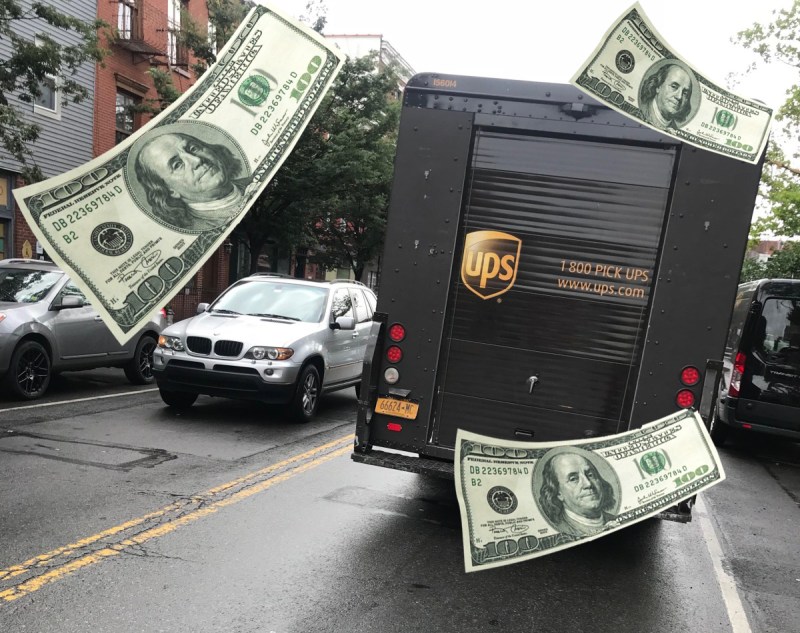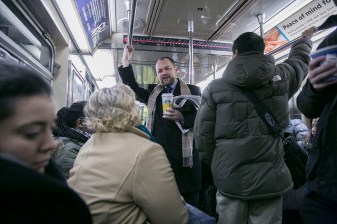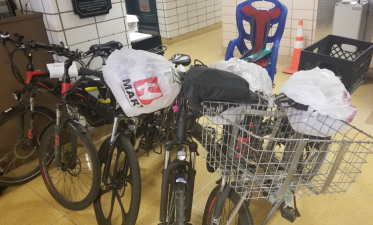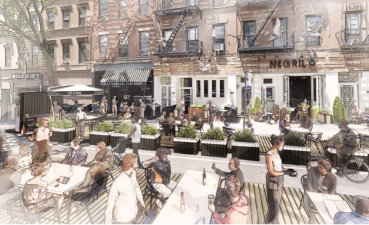Council to Seek Per-Minute Charge on E-Commerce Companies Like Amazon and UPS

The city should impose a tax on e-commerce companies like Amazon, UPS, and FedEx for the time they spend traveling the congested streets of New York City, a new Council-commissioned report released Tuesday argues.

The 21-page study by mobility expert (and Streetsblog contributor) Charles Komanoff says that imposing per-minute charges on the thousands of delivery vehicles would reduce gridlock, reduce pollution, speed buses, incentivize more sustainable ways of bringing in packages like cargo bikes, which would not be charged, and cut the estimated $400 million that New Yorkers lose sitting in e-commerce-delivery-caused traffic.
“Delivery vehicles conveying e-commerce purchases to New Yorkers are imposing singular burdens on the urban commons,” the report states. “They fan out across the five boroughs, occupying public roads and streets more or less continuously throughout their shift. During that time they take up space, exacerbating traffic congestion and adding to air pollution and greenhouse gas emissions.”
The per-truck charges would be based on the area in which the companies are delivering, ranging from as high as $1.04 per minute midday during the week in Manhattan’s Central Business District (below 60th Street), to as low as 2 cents per minute for overnight deliveries in adjacent neighborhoods in Brooklyn, Queens, and the Bronx (see chart). Translated to a per package basis, those fees would range from roughly $1.65 during peak midday times to a low of $0.10 per package in the CBD, and from $0.45 to $0.05 per package in the adjacent neighborhoods, according to the report.
The exempted neighborhoods in “outlying parts” of the city “aren’t congested enough to warrant charging delivery vehicles there,” the report states. The more congested areas slated for the charge account for around half of city households and slightly more than half of the estimated 2.4 million e-commerce deliveries made every day by nearly 8,000 trucks.
Currently, delivery trucks have been able to park with impunity, racking up thousands of dollars in tickets. No wonder, Council Speaker Corey Johnson called Komanoff’s findings “important” and “innovative,” and the start to a much-needed public policy shift regarding e-commerce delivery and its impact on city streets.
“Our city is facing worsening congestion on our streets, which causes increasingly slower average bus speeds and contributes to air pollution. This proposal to charge package delivery vehicles for the time they spend on the curb and on the most congested streets could help significantly reduce gridlock and improve transportation efficiency in NYC,” Johnson said in a statement. “How we use our city’s streets has to keep up with new developments like the huge increase of e-commerce deliveries in the last decade, and I am excited for the public conversation to come around this and other proposals to help us manage new street usage patterns in a sustainable way for years to come.”
There’s another key benefit to charging delivery companies for occupying the city’s public spaces: “To help level the playing field for traditional ‘brick-and-mortar’ businesses that pay property taxes and often function as neighborhood anchors,” the report states.
Like any pricing externality, it would be up to each private company to decide how to handle the cost, and whether those charges would be passed onto the consumer or not — unlike Brooklyn Assembly Member Robert Carroll’s proposal from back in 2019, which suggested levying a $3-per-package fee on deliveries. But regardless of who pays, Komanoff says, the revenue would be collected by the city and go towards improving its transportation and streetscape.
And the tax would also incentivize e-commerce companies to cut back on package waste to pack more boxes in each truck, transition to cargo bike deliveries, or expand local walk-in distribution centers, which would all eventually help reduce the number of delivery trucks, and congestion, according to Komanoff.

“We expect that, in the nature of profit-maximizing enterprises, the businesses would be further incentivized to undertake efficiencies and other logistical changes in the interest of retaining market share and reducing the incidence of the charges on their bottom lines,” the report says.
The charge would apply only in Manhattan and inner-ring neighborhoods because that’s where the congestion is most exacerbated by delivery vehicles. In the Central Business District of Manhattan — which has 10 percent of the city’s households, but gets 13 percent of the city’s e-commerce deliveries — there are 34,700 deliveries per square mile per day.
“It is also the most affluent by far of the four districts, with household incomes averaging at least 50 percent greater than the other three districts,” the report states.
By comparison, the city’s most outlying areas — the zone in dark green in the map above — get about 4,100 deliveries per square mile per day. This area accounts for just 22 percent of the city’s e-commerce deliveries.
The per-minute charge on delivery truck proposal follows a similar one Komanoff released earlier this year, which also called for charging 11 cents for every minute that app-based cabs like Uber and Lyft sit or drive around empty; and it would complement the long-delayed congestion pricing scheme that will similarly toll private vehicles entering the CBD.
Delivery trucks would be subject to a congestion fee to enter the central business district, but the toll will be collected only once per vehicle per day and, as such “is unlikely to capture more than a small percentage of e-delivery vehicles’ congestion costs,” the report states.
Amazon and UPS did not respond to a request for comment.
The report was released just as the council took up four bills designed to curb congestion and encourage safer, and more sustainable deliveries — its Transportation Committee voted Tuesday in favor of creating a pilot program for micro-distribution centers, ensuring that loading zones are not blocked or obstructed, and expanding loading zones throughout the city.




